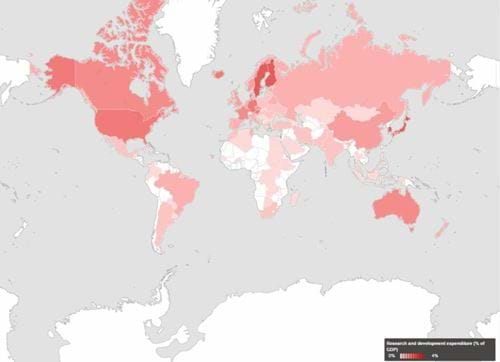Day 147: Funding for life

21st October 2014
Author: Geoff Maitland, IChemE President 2014–2015.
It shouldn't surprise anyone when I say that some of the most successful nations and organisations in the world are the ones that invest heavily in research. It is a way to fuel growth, improve competitiveness, efficiency, quality of life and much more.

Some of the latest data from The World Bank shows who are the biggest researchers, as a percentage of their Gross Domestic Product (GDP).
There are some surprises, but in general the biggest spenders are in Europe and North America.
The top 20 includes Israel (1st), Finland (2nd), Sweden (3rd), Denmark (4th), Germany (5th), Austria (6th), Slovenia (7th), United States (8th), France (9th), Belgium (10th), Estonia (11th), Netherlands (12th), Singapore (13th), China (14th), Czech Republic (15th), Canada (16th), Ireland (17th), United Kingdom (18th), Norway (19th) and Portugal (20th).
In our technical policy - Chemical Engineering Matters - we highlight why research is important and the contribution that chemical engineering can make on big issues like food, water, energy and health. In the strategy we say: "This report has identified a huge range of possibilities where chemical engineers can shape the future.
"IChemE will work to identify shining examples of chemical engineering research that offer real potential to change lives. It will act as a broker between the researchers, funding bodies and industry to build a confident and outward-looking international chemical engineering community that will play its part fully in building a more sustainable future."
Chemeng365 is one of my contributions to this ambition, and I would urge all chemical engineers, with great stories to share, to work with their PR and marketing teams to promote their achievements to the wider public.
People affected by CF, and their carers, will know that timely knowledge of a lung infection helps prevent life-shortening permanent damage to their already vulnerable airways. They need to seek immediate treatment.
Thanks to engineers at University of California, Irvine (UCI) - and a grant of US$1.3 million from the National Science Foundation (NSF) - they have developed a prototype low-cost, disposable lung infection detector.
The device can be used by people with cystic fibrosis, along with a smartphone, to immediately detect a lung infection, much like the device police use to gauge a driver’s blood alcohol level.

Associate professor of chemical engineering and materials science, Regina Ragan, and electrical engineer Filippo Capolino have created a nano-optical sensor that can detect trace levels of infection in a small sample of breath.
In addition to diagnosing medical conditions, the device could be modified to monitor environmental conditions – for instance, identifying harmful airborne agents produced through automotive or chemical industry practices.
Nanotechnologies such as this sensor depend on extremely small, nanometer-scale building blocks. A nanometer is about 100,000 times smaller than the width of a human hair.
Fabricating on this tiny scale poses huge challenges, since most of the current methods that achieve a high level of precision are too costly and slow to be viable for manufacturing.
Regina says: “With support from the NSF and input from industry, our goal is to help nanoscale manufacturing processes leave the laboratory – where they've been confined – and become usable in widespread commercial applications.”
As a profession we can achieve so much. It's up to use to keep shouting loudly for the funding that people like Regina can use so effectively.
ChemEng365 blog
Geoff Maitland launched this blog during his IChemE presidency in 2014. ChemEng365 features 365 chemical engineering successes and achievements throughout his year-long presidency.